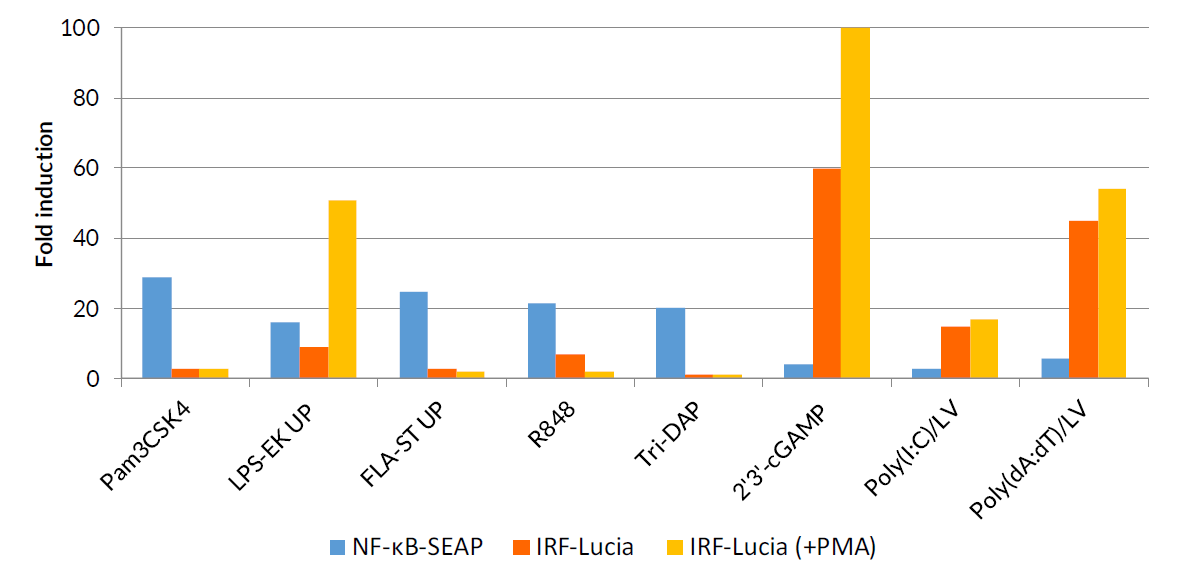THP1-Dual™ Cells
| Product | Unit size | Cat. code | Docs. | Qty. | Price | |
|---|---|---|---|---|---|---|
|
THP1-Dual™ Cells NF-κB-SEAP and IRF-Lucia luciferase reporter monocytes |
Show product |
3-7 x 10e6 cells |
thpd-nfis
|
|
||
|
THP1-Dual™ vial Additional cell vial |
Show product |
3-7 x 10e6 cells |
thpd-nfis-av
|
Notification: Reference #thpd-nfis-av can only be ordered together with reference #thpd-nfis.
NF-κB–SEAP and IRF–Lucia reporter human monocytes
THP1-Dual™ cells were derived from the human THP-1 monocyte cell line by stable integration of two inducible reporter constructs.
As a result, THP1-Dual™ cells allow the simultaneous study of the NF-κB pathway, by monitoring the activity of SEAP, and the IRF pathway, by assessing the activity of a secreted luciferase, Lucia luciferase.
Both reporter proteins are readily measurable in the cell culture supernatant when using QUANTI-Blue™ Solution, a SEAP detection reagent, and QUANTI-Luc™ 4 Lucia/Gaussia, a Lucia and Gaussia luciferase detection reagent.
THP1-Dual™ cells induce the activation of NF-κB in response to certain TLR agonists, such as Pam3CSK4 and flagellin. They trigger the IRF pathway upon stimulation with type I IFNs and RLR or CDS agonists, such as transfected dsRNA.
THP1-Dual™ cells are resistant to the selectable markers Zeocin® and blasticidin.
Back to the topSpecifications
Antibiotic resistance: Zeocin®, blasticidin
Growth medium: RPMI 1640, 2 mM L-glutamine, 25 mM HEPES, 10% heat-inactivated fetal bovine serum, 100 μg/ml Normocin™, Pen-Strep (100 U/ml-100 μg/ml)
Guaranteed mycoplasma-free
Back to the topContents
- 3-7 x 106 of THP1-Dual™ cells in a cryovial or shipping flask
- 1 ml of Normocin™ (50 mg/ml)
- 1 ml of Zeocin® (100 mg/ml)
- 1 ml of Blasticidin (10 mg/ml)
- 1 tube of QUANTI-Luc™ 4 Reagent, a Lucia luciferase detection reagent (sufficient to prepare 25 ml)
- 1 ml of QB reagent and 1 ml of QB buffer (sufficient to prepare 100 ml of QUANTI-Blue™ Solution, a SEAP detection reagent)
![]() THP1-Dual™ cells are shipped on dry ice (Europe, USA, Canada, and some areas in Asia)
THP1-Dual™ cells are shipped on dry ice (Europe, USA, Canada, and some areas in Asia)
Back to the top
Description
THP1-Dual™ cells feature the Lucia gene, a secreted luciferase reporter gene, under the control of an ISG54 minimal promoter in conjunction with five IFN-stimulated response elements.
THP1-Dual™ cells also express a secreted embryonic alkaline phosphatase (SEAP) reporter gene driven by an IFN-β minimal promoter fused to five copies of the NF-κB consensus transcriptional response element and three copies of the c-Rel binding site.
As a result, THP1-Dual™ cells allow the simultaneous study of the NF-κB pathway, by monitoring the activity of SEAP, and the IRF pathway, by assessing the activity of Lucia luciferase.
Back to the top





